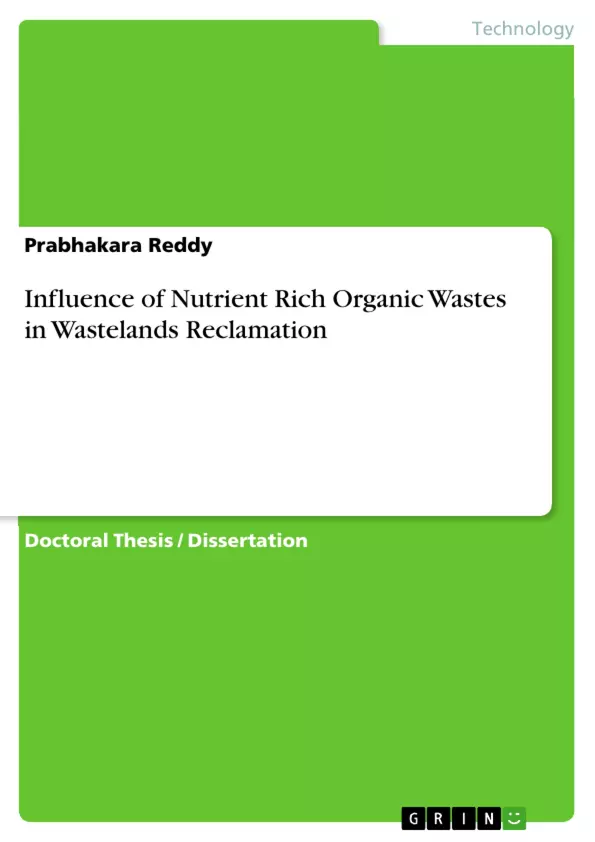Exploration for natural resources and their utilization are present ever since the existence of human civilization. In India, land and water resources are the two important ones which determine our development. We possess large geographical area of 329 M.ha and unfortunately, nearly half of it is characterized with low soil fertility. Thus, nutrient limitation is an issue of concern in these marginal lands and several initiatives have been made in the past on their improvement. In contrast, we are also seeing nutrient surplus situations, sometimes even toxicities, in urban areas due to domestic and industrial waste disposals. Chemically, these wastes are organic in nature and rich in plant nutrients. An attempt was made to match these contrasting situations i.e. application of nutrient rich organic wastes to meet the nutrient requirements of tree species planted on less fertile wastelands. Thus, the objectives of the experiment were,
- To characterize the wastelands in terms of physical and chemical features as soil limiting factors in afforestation programme
- To characterize domestic and agro-industrial organic wastes for suitability as nutrient source in afforestation programme
- To evaluate the changes in physical and chemical properties of wasteland soils due to organic wastes application
- To evaluate the growth performance of tree species due to organic wastes application in wastelands
Table of Contents
- I. INTRODUCTION
- II. REVIEW OF LITERATURE
- 2.1. Wastelands: Definition and Features
Objectives and Key Themes
The main objective of this research was to investigate the feasibility of using nutrient-rich organic wastes from urban and agro-industrial sources to improve the soil fertility of wastelands and promote tree growth. The study aimed to characterize wastelands, analyze the nutrient content of various organic wastes, evaluate the effects of waste application on soil properties, and assess the growth performance of different tree species.
- Wasteland characterization and reclamation
- Nutrient analysis of organic wastes
- Impact of organic waste application on soil properties
- Growth performance of tree species in treated wastelands
- Sustainable resource management
Chapter Summaries
I. INTRODUCTION: This introductory chapter establishes the context of the research by highlighting the contrasting situations of nutrient-depleted wastelands and nutrient-rich organic wastes generated from urban and industrial activities. It emphasizes the need for sustainable resource management and explores the potential of utilizing organic wastes for wasteland reclamation. The chapter frames the research problem, underscoring the environmental and economic implications of both wasteland degradation and improper waste disposal. The dual challenge of restoring degraded lands while addressing waste management is clearly presented, setting the stage for the subsequent investigation.
II. REVIEW OF LITERATURE: This chapter provides a comprehensive review of existing literature on wastelands and organic waste utilization. It defines wastelands, detailing their characteristics and the challenges associated with their restoration. The chapter then explores various types of organic wastes, their nutrient content, and their potential applications in soil amendment. A key focus is on the potential benefits and risks associated with using organic wastes in land reclamation, including the presence of heavy metals in some waste streams. The review sets the stage for the experimental work by summarizing the current understanding of the relevant scientific literature.
Keywords
Wasteland reclamation, organic waste, nutrient management, soil fertility, tree growth, sustainable agriculture, agro-industrial waste, municipal waste, heavy metals, afforestation.
Frequently Asked Questions: Comprehensive Language Preview
What is the main objective of this research?
The main objective is to investigate the feasibility of using nutrient-rich organic wastes from urban and agro-industrial sources to improve the soil fertility of wastelands and promote tree growth. This includes characterizing wastelands, analyzing waste nutrient content, evaluating the effects of waste application on soil properties, and assessing tree species growth performance.
What are the key themes explored in this research?
Key themes include wasteland characterization and reclamation, nutrient analysis of organic wastes, the impact of organic waste application on soil properties, the growth performance of tree species in treated wastelands, and sustainable resource management.
What is covered in the Introduction chapter?
The introduction establishes the research context by highlighting the contrast between nutrient-depleted wastelands and nutrient-rich organic wastes. It emphasizes sustainable resource management, explores using organic wastes for reclamation, frames the research problem (including environmental and economic implications), and presents the dual challenge of restoring degraded lands while addressing waste management.
What is covered in the Literature Review chapter?
This chapter comprehensively reviews existing literature on wastelands and organic waste utilization. It defines wastelands, details their characteristics and restoration challenges, explores various organic waste types and their nutrient content, and examines potential applications in soil amendment. It also focuses on the benefits and risks of using organic wastes in land reclamation, including heavy metal presence.
What are the key words associated with this research?
Key words include: Wasteland reclamation, organic waste, nutrient management, soil fertility, tree growth, sustainable agriculture, agro-industrial waste, municipal waste, heavy metals, and afforestation.
What is the structure of this document?
This document provides a comprehensive language preview including the title, table of contents, objectives and key themes, chapter summaries, and keywords.
- Quote paper
- Prabhakara Reddy (Author), 2014, Influence of Nutrient Rich Organic Wastes in Wastelands Reclamation, Munich, GRIN Verlag, https://www.hausarbeiten.de/document/268299


